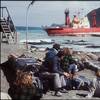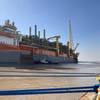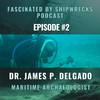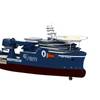The U.K.'s largest Port Authority has specified a Caterpillar 3056 marine engine to provide propulsion power onboard a new 32-ft. (9.7-m) salvage cutter. The Port of London Authority ordered the new vessel to replace an aging cutter, which has been part of a team of three boats providing support for the authority's two salvage ships Hookness and Crossness since the early 1970s. Being built by Wickham Marine of Colchester using an innovative jig system, which creates a mold in which the steel-hull vessel is built, the boat is open-decked and similar in design to its predecessor. The build method means that the vessel is built from the outside in, i.e. the hull structure is built first, before equipment and systems are installed. The method requires considerable work when building the first hull, but reportedly makes the construction of subsequent vessels, using the same mold, time and cost efficient.
Wickham Targets Small Workboats
Wickham Marine of Colchester is targeting the smaller end of the workboat market with a new jig-based construction method. The company is able to offer the same combination of rugged hull design and vessel-matched Caterpillar power, as well as a new range of multi-purpose 29, 39 and 49-ft. (9, 12 and 15-m) jig-built vessels, to other port authorities and operators of small general purpose workboats worldwide. Using this 'jig' method — which requires precisely measured, CNC machined steel plates, future copies of the same vessel using the same mold become very cost effective. Interestingly, Wickham did not charge the Port of London Authority for the design of the initial vessel, on the basis that the builder retained the right to market the product more widely in order to grow to business. "We are using the same build method for a new Cat-powered nine-meter workboat, and will do the same for a 15-m workboat featuring twin Cat 3056 engines shortly," said Stuart Eldridge, company director. "At this stage, we are building for sale rather than to order, so confident are we that there is a strong level of demand for simple, robust and well-designed steel-built workboats both in Europe and beyond, and this is one of the reasons why we prefer Caterpillar engines." The new PLA cutter is extremely robust, with 6 mm shell plating and very heavy lateral framing to protect it against crushing when operating between vessel hulls and wharves, or when handling wires for the mother salvage ship. The Cat power onboard, a 3056NA engine rated 125 bhp at 2,600 rpm is integral to a propulsion system that features a sealed keel cooling arrangement, designed to eliminate the problem of cooling water inlet filters being blocked by the silt and other debris in the River Thames. The engine is also supplied with a Power Take Off (PTO) shaft and three grove pulley.
It is not the most complex or sophisticated vessel in the world, but it does play a key role in our navigation maintenance and salvage operations … and it will need to be reliable and robust for a great many years of service."
The new vessel joins a fleet of 40 engaged in maintaining quality navigation between the entrance to the Thames estuary and Teddington lock.
Subscribe for
Maritime Reporter E-News
Maritime Reporter E-News is the maritime industry's largest circulation and most authoritative ENews Service, delivered to your Email five times per week












